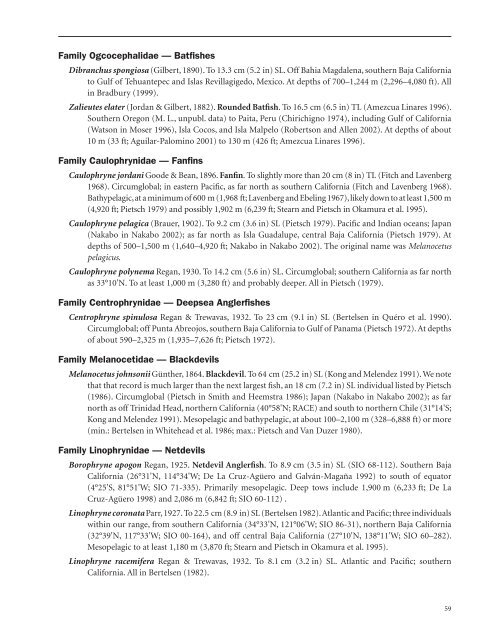Untitled - Alaska Resources Library
Untitled - Alaska Resources Library
Untitled - Alaska Resources Library
You also want an ePaper? Increase the reach of your titles
YUMPU automatically turns print PDFs into web optimized ePapers that Google loves.
Family Ogcocephalidae — Batfishes<br />
Dibranchus spongiosa (Gilbert, 1890). To 13.3 cm (5.2 in) SL. Off Bahia Magdalena, southern Baja California<br />
to Gulf of Tehuantepec and Islas Revillagigedo, Mexico. At depths of 700–1,244 m (2,296–4,080 ft). All<br />
in Bradbury (1999).<br />
Zalieutes elater (Jordan & Gilbert, 1882). Rounded Batfish. To 16.5 cm (6.5 in) TL (Amezcua Linares 1996).<br />
Southern Oregon (M. L., unpubl. data) to Paita, Peru (Chirichigno 1974), including Gulf of California<br />
(Watson in Moser 1996), Isla Cocos, and Isla Malpelo (Robertson and Allen 2002). At depths of about<br />
10 m (33 ft; Aguilar-Palomino 2001) to 130 m (426 ft; Amezcua Linares 1996).<br />
Family Caulophrynidae — Fanfins<br />
Caulophryne jordani Goode & Bean, 1896. Fanfin. To slightly more than 20 cm (8 in) TL (Fitch and Lavenberg<br />
1968). Circumglobal; in eastern Pacific, as far north as southern California (Fitch and Lavenberg 1968).<br />
Bathypelagic, at a minimum of 600 m (1,968 ft; Lavenberg and Ebeling 1967), likely down to at least 1,500 m<br />
(4,920 ft; Pietsch 1979) and possibly 1,902 m (6,239 ft; Stearn and Pietsch in Okamura et al. 1995).<br />
Caulophryne pelagica (Brauer, 1902). To 9.2 cm (3.6 in) SL (Pietsch 1979). Pacific and Indian oceans; Japan<br />
(Nakabo in Nakabo 2002); as far north as Isla Guadalupe, central Baja California (Pietsch 1979). At<br />
depths of 500–1,500 m (1,640–4,920 ft; Nakabo in Nakabo 2002). The original name was Melanocetus<br />
pelagicus.<br />
Caulophryne polynema Regan, 1930. To 14.2 cm (5.6 in) SL. Circumglobal; southern California as far north<br />
as 33°10'N. To at least 1,000 m (3,280 ft) and probably deeper. All in Pietsch (1979).<br />
Family Centrophrynidae — Deepsea Anglerfishes<br />
Centrophryne spinulosa Regan & Trewavas, 1932. To 23 cm (9.1 in) SL (Bertelsen in Quéro et al. 1990).<br />
Circumglobal; off Punta Abreojos, southern Baja California to Gulf of Panama (Pietsch 1972). At depths<br />
of about 590–2,325 m (1,935–7,626 ft; Pietsch 1972).<br />
Family Melanocetidae — Blackdevils<br />
Melanocetus johnsonii Günther, 1864. Blackdevil. To 64 cm (25.2 in) SL (Kong and Melendez 1991). We note<br />
that that record is much larger than the next largest fish, an 18 cm (7.2 in) SL individual listed by Pietsch<br />
(1986). Circumglobal (Pietsch in Smith and Heemstra 1986); Japan (Nakabo in Nakabo 2002); as far<br />
north as off Trinidad Head, northern California (40°58'N; RACE) and south to northern Chile (31°14'S;<br />
Kong and Melendez 1991). Mesopelagic and bathypelagic, at about 100–2,100 m (328–6,888 ft) or more<br />
(min.: Bertelsen in Whitehead et al. 1986; max.: Pietsch and Van Duzer 1980).<br />
Family Linophrynidae — Netdevils<br />
Borophryne apogon Regan, 1925. Netdevil Anglerfish. To 8.9 cm (3.5 in) SL (SIO 68-112). Southern Baja<br />
California (26°31'N, 114°34'W; De La Cruz-Agüero and Galván-Magaña 1992) to south of equator<br />
(4°25'S, 81°51'W; SIO 71-335). Primarily mesopelagic. Deep tows include 1,900 m (6,233 ft; De La<br />
Cruz-Agüero 1998) and 2,086 m (6,842 ft; SIO 60-112) .<br />
Linophryne coronata Parr, 1927. To 22.5 cm (8.9 in) SL (Bertelsen 1982). Atlantic and Pacific; three individuals<br />
within our range, from southern California (34°33'N, 121°06'W; SIO 86-31), northern Baja California<br />
(32°39'N, 117°33'W; SIO 00-164), and off central Baja California (27°10'N, 138°11'W; SIO 60–282).<br />
Mesopelagic to at least 1,180 m (3,870 ft; Stearn and Pietsch in Okamura et al. 1995).<br />
Linophryne racemifera Regan & Trewavas, 1932. To 8.1 cm (3.2 in) SL. Atlantic and Pacific; southern<br />
California. All in Bertelsen (1982).<br />
59
















